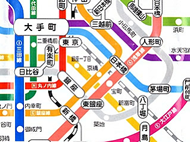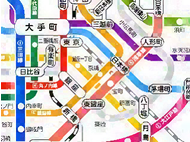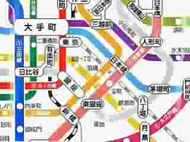29th Annual RESNA Conference Proceedings
Auxiliary Support-System for the Independent Traveler Using an Electric Wheelchair
Iwao SEKITA*1), Hidenori SAKANASHI*1), Yuka KORI*2), Hiroyuki MORI*2), and Tetsuya HIGUCHI*1)
*1) ASRC, National Institute of Advanced Industrial Science and Technology (AIST) Tsukuba, Ibaraki 305-8568, Japan
*2) Graduate School of Science, Toho University.
ABSTRACT
This paper proposes an auxiliary support-system for severely - handicapped persons so they can travel easily and independently using an electric wheelchair. The system allows a severely - handicapped person to send images together with a request for assistance to a remote supporter and to receive voice assistance via a wireless network based on cellular phones and wireless-LANs . The system can also transmit the supporter's voice to persons in the vicinity of the wheelchair for translations and messages of warning. Moreover, the system can display the route with the least barriers between a point of departure and a destination. In realizing this system , we have adopt ed our image compression method , which has the advantage of providing images that are relatively free of distortion even at high data-compressions .
KEYWORDS
Remote support, auxiliary system, electric wheelchair, independent traveler, image compression
BACKGROUND
An electric wheelchair is important for severely - handicapped persons in order to achieve independent travel. Based on consultation with electric wheelchair users, their families and staff at welfare centers , we have identified the following four areas of special concern when a severely-handicapped person uses an electric wheelchair.
- Ability to observe the user
Parents and welfare center staff want to be able to watch their small children , when they are using electric wheelchairs to go and return from school or the bus-stop, or elderly parents , when they are going out .
When a wheelchair user moves out of the wheelchair , like getting in to bed , they like to have a supporter watching over them .
- Interpretation .
A person suffering from allophasis would sometimes like to have their speech interpreted to persons nearby .
- Navigation.
Wheelchair users often require directions, because they have become lost or they have difficulties in reading a map.
Furthermore, some wheelchair users want advice about the availability of alternatives when needing to make some purchase.
- Emergency call.
When a wheelchair user encounters some trouble with the electric wheelchair (for example , a dead battery or a flat tire), they would like to have some quickly come to their assistance . Wheelchair users want to prevent such trouble s as far as possible .
METHODOLOGY
We propose a remote-support system as an auxiliary system for severely - handicapped person s who us e an electric wheelchair.
The system for the electric wheelchair consists primarily of (1) a camera , (2) a personal computer (PC), (3) a wireless-communication card, (4) GPS and (5) a device for input-and-output signals.
- Camera
Three types of camera can be used- A common PTZ (pan/tilt/zoom) camera,
- a very small camera, and
- a stereo omni-directional camera [1]
This camera is for future versions of the system .
- A user usually selects one type of cameras.
- PC;
The PC is to control the camera , to compress data for transmission , to handle voice communication , and to display a map of the wheelchair user's surroundings. - A wireless-communication card;
For example, both a cellular-phone card for wide -area communication , and a wireless-LAN card with broadband for use in a particular local area to transmit high-quality information. - GPS;
By using GPS, a remote supporter can know the exact position of the wheelchair user, and so can advise the user about which direction to go. - A device for input-and-output signals;
This is a switching interface controlling the video transmissions, etc , because wheelchair users do not require constant assistance .
RESULTS AND DISCUSSION
Images Provided by Our System
The following four settings are situations in which electric wheelchair users require remote support . Our system can provide several types of image according to the situation.
(Situation 1) Observing user movements
When a wheelchair is moving, a remote supporter will sometimes want to be able to observe the environment in which the user is moving through . The system can provide gray images or color images at small size/resolutions (320 x 240, 160 x 120 pixels) in order to increase the frames per second (fps).
(Situation 2) Viewing a wide area in detail
When the remote supporter want s to view a wide area in detail , for instance, in order to ascertain any dangers around the user , the system can provide a color image with VGA size/resolution (640x 480).
(Situation 3) Highlighting a particular area in detail (a PTZ camera only)
When a remote supporter want s to check out the environmental information, such as signs in the distance, the PTZ camera can easily be adjust ed to bring a particular area into clear view.
(Situation 4) Wanting an omnidirectional view of a location (a stereo omni-directional camera only)
When a remote supporter want s to check on the movements of others in the users vicinity, such as a bicycle approaching from the rear, in the future, the system will be able to provide an omnidirectional view with a stereo omnidirectional camera [1]. Moreover, this camera system linked to the personal computer will be able to automatically detect dangers and the emergency situations [1].
Our Image Compression Method
When using a cellular-phone card, transmission capacities are low and subject to variation due to the locality . It is important to compress the size of an image with QVGA (320 x 240 pixels) down to levels of less than several KB (1/30 or less) while retaining image quality.
Figure 1 (a) shows an example of original image, (b) shows a reconstructed image by our data compression method, and (c) shows a JPEG image. Figs (b) and (c) are almost same data size.
Using our compression method with our color space conversion [2] , we are able to obtain better quality images than conventional images (JPEG) for the very low data sizes.
REFERENCES
- Y. Sato, & K. Sakaue (2005). Development of running environment risk detection system for electric wheelchair based on stereo omni-directional system, Nat. Conf. Rec. of Inst. of Life Support Engineering of Japan, p.140 (in Japanese).
- Y. Kori, I. Sekita, H. Sakanashi, T. Furuya, & T. Higuchi (2004). Block truncation coding with a new color space conversion for the low bit-rate communication, Nat. Conv. Rec. of Inst. of Image Information and Television Engineers (in Japanese).
Author Contact Information:
Iwao SEKITA , Dr.Eng. , ASRC
National Institute of Advanced Industrial Science and Technology (AIST)
1-1-1 Umezono
Tsukuba, Ibaraki 305-8568, Japan
Office Phone +81- ( 29 ) 861 - 5840
EMAIL: i-sekita@aist.go.jp
This should be in the right column.


